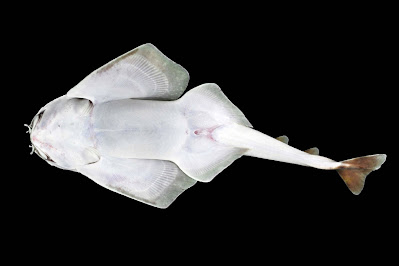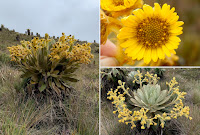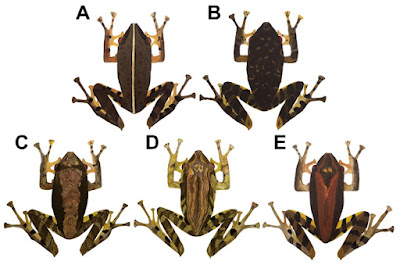 |
| Cyrtodactylus stellatus Termprayoon, Rujirawan, Ampai, Wood & Aowphol, 2021 |
Abstract
The bent-toed geckos of the Cyrtodactylus pulchellus group are widely distributed along the Thai-Malay Peninsula. Although taxonomic and phylogenetic studies of this species group have been continuously conducted, only some populations from Thailand have been included, resulting in hidden diversity within this group. In this study, we used morphological and molecular data to clarify the taxonomic status and describe a new population from Tarutao Island, Satun Province, southern Thailand. Cyrtodactylus stellatus sp. nov. can be distinguished from its congeners by the combination of the following morphological characters: body size; tuberculation; number of dark body bands, ventral scales, and femoroprecloacal pores in males; presence of precloacal pores in females; and scattered pattern on dorsum. Phylogenetic analyses of the mitochondrial ND2 gene recovered the new species as the sister species to C. astrum, with an uncorrected pairwise divergence of 9.78–12.37%. Cyrtodactylus stellatus sp. nov. is currently only known from Tarutao Island, Thailand. The discovery of this species suggests that the diversity within the C. pulchellus group remains underestimated and future exploration of unsurveyed areas are needed to further the understanding of this group and its geographic range.
Keywords: Cyrtodactylus astrum, Cyrtodactylus stellatus sp. nov., karst, morphology, phylogeny, taxonomy
 |
| Map showing the type locality of Cyrtodactylus stellatus sp. nov. from Tarutao Island, Mueang Satun District, Satun Province, Thailand and the type localities of closely related species, C. astrum, C. dayangbuntingensis, C. langkawiensis, and C. lekaguli. |
 |
| Adult male holotype of Cyrtodactylus stellatus sp. nov. (ZMKU R 00905) from Tarutao Island, Satun Province. A specimen in life and immediately before preservative: B dorsal and C ventral views. |
Cyrtodactylus stellatus sp. nov.
Stellar Bent-toed Gecko
Diagnosis: Cyrtodactylus stellatus sp. nov. can be distinguished from all other species of the C. pulchellus group by the combination of the following characters: (1) SVL 86.3–95.9 mm in adult males, 86.6–96.1 mm in adult females; (2) 12–15 supralabial and 10–13 infralabial scales; (3) weak tuberculation on body; (4) no tubercles on ventral surfaces of forelimbs, gular region, or in ventrolateral body folds; (5) 32–47 paravertebral tubercles; (6) 19–23 longitudinal rows of dorsal tubercles; (7) 32–40 rows of ventral scales; (8) 20–23 subdigital lamellae on the fourth toe; (9) 24–29 femoroprecloacal pores in adult males; (10) precloacal pores present in adult females; (11) deep precloacal groove in males; (12) dorsum bearing a scattered pattern of white tubercles; (13) four dark dorsal body bands; (14) 10–12 dark caudal bands on original tail; (15) white caudal bands in adults heavily infused with dark pigmentation; and (16) posterior portion of tail in hatchlings and juveniles white.
Distribution: Cyrtodactylus stellatus sp. nov. is currently known only from Tarutao Island, Satun Province, Thailand (Figs 1, 12A).
Natural history:
All specimens of C. stellatus sp. nov. were collected from a karst forest at night (1950–2100 h) with temperatures between 27.1–32.2 °C and relative humidity between 71.4–93.0%. The specimens were found on karst walls, within karst crevices and on nearby karst boulders. Some specimens occurred on tree trunks or vines near the karst formations (Fig. 12). The holotype was found on a karst wall approximately 1 m above the ground within karst forest. Eight specimens (ZMKU R 00900, ZMKU R 00906, ZMKU R 00908, ZMKU R 00911–00912, ZMKU R 00913, and ZMKU R 00915–00916) were found on karst walls from 0.5–3.0 m above the ground. ZMKU R 00907, ZMKU R 00910, and ZMKU R 00914 were found in karst crevices. Three specimens (ZMKU R 00901, ZMKU R 00903, and ZMKU R 00909) were found on karst boulders. Four specimens (ZMKU R 00899, ZMKU R 00902, ZMKU R 00904, and ZMKU R 00917) were perched on vegetation near karst walls or karst boulders.
Two gravid females (ZMKU R 00899–00900) were collected in November 2017 and contained two eggs (externally visible). The juvenile was found on a vine in May 2019. Cyrtodactylus stellatus sp. nov. appears to be nocturnal and sympatric with two other gekkonids, Gehyra mutilata Wiegmann, 1834 and the diurnal species Cnemaspis tarutaoensis Ampai et al., 2019.
Etymology: The specific epithet stellatus is Latin word, meaning starry or starred, and refers to scattered pattern of light-colored tubercles on dorsum and limbs. The name corresponds with the sister taxon C. astrum that shared similar diagnostic character (scattered light-colored tubercles pattern on dorsum).
Korkhwan Termprayoon, Attapol Rujirawan, Natee Ampai, Perry L. Wood Jr and Anchalee Aowphol. 2022. A New Insular Species of the Cyrtodactylus pulchellus Group (Reptilia, Gekkonidae) from Tarutao Island, southern Thailand revealed by Morphological and Genetic Evidence. ZooKeys. 1070: 101-134. DOI: 10.3897/zookeys.1070.73659
Natee Ampai, Attapol Rujirawan, Perry L. Wood Jr, Bryan L. Stuart and Anchalee Aowphol. 2019. Morphological and Molecular Analyses reveal Two New Insular Species of Cnemaspis Strauch, 1887 (Squamata, Gekkonidae) from Satun Province, southern Thailand. ZooKeys. 858: 127-161. DOI: 10.3897/zookeys.858.34297
L. L. Grismer, Perry L. Wood, Jr., Evan S. H. Quah, Shahrul Anuar, MohD. A. Muin, Montri Sumontha, Norhayati Ahmad, Aaron M. Bauer, Sansareeya Wangkulangkul, Jesse L. Grismer and Olivier S. G. Pauwels. 2012. A Phylogeny and Taxonomy of the Thai-Malay Peninsula Bent-toed Geckos of the Cyrtodactylus pulchellus complex (Squamata: Gekkonidae): combined morphological and molecular analyses with Descriptions of Seven New Species. Zootaxa. 3520: 1-55. Researchgate.net/publication/234032436















































